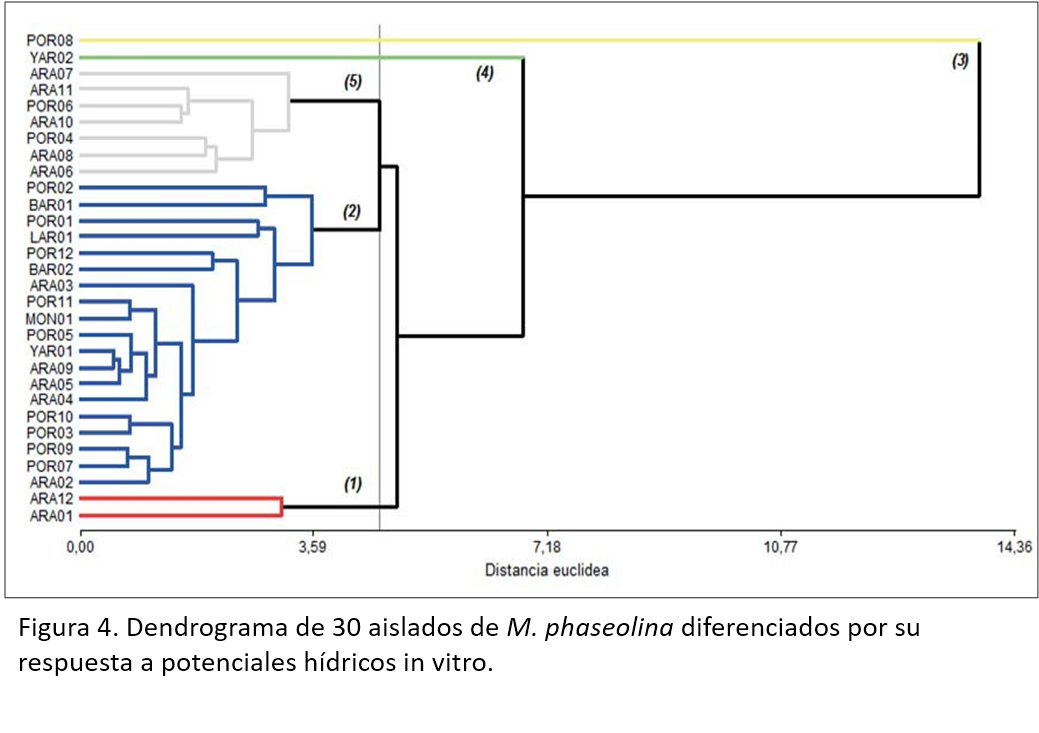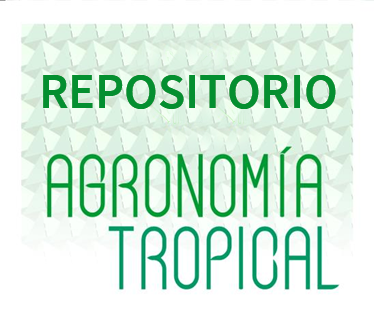Genetic and pathogenic characterization of Macrophomina phaseolina (Tassi) Goid isolates and their response to water deficit
Abstract
Macrophomina phaseolina (Tassi) Goid. is a phytopathogenic fungus with wide morphological, genetic, pathogenic and physiological variability. This versatility is increased due to its adaptability to different host species and stressful environmental conditions, such as water deficiency and high temperatures. The objective of this work was to characterize M. phaseolina isolates, from the genetic and pathogenic point of view, as well as their response to water deficit. Intermicrosatelite markers (ISSR) were used for the genetic characterization of the isolates. To determine the pathogenicity, 30 isolates were inoculated on cotyledonal leaves of black bean (Phaseolus vulgaris L.) var. Tacarigua. The response to water deficit was carried out at different concentrations NaCl in vitro on the growth of the mycelium of M. phaseolina. The linear correlation test was applied between Mantel matrices to identify the degree of association between the analyzed factors. The fungus exhibited high polymorphism, which indicates genetic diversity among the isolates from black bean from different geographical areas. In the pathogenic characterization, the differentiation of expressions of the infection in cotyledonal black bean leaves was evidenced. Also, there was an inhibitory effect on the mycelial growth of the isolates based on the osmotic potential (Ψo), due to the presence of NaCl. The genetic diversity was not related to pathogenicity, nor to the response to water deficit conditions, that is, they behaved independently
Downloads
References
• Bañuelos-Balandrán, JJ; Mayek-Pérez, N. 2008. Evaluación no destructiva de la patogenicidad de Macrophomina phaseolina (Tassi) Goid. en frijol (Phaseolus vulgaris L.). Revista Mexicana de Fitopatología 26(1):71-75.
• Beas, R; Reyes, MC; Medina, M. 2004. Macrophomina phaseolina (Tassi) Goid en frijol (Phaseolus vulgaris L.) de Aguascalientes: relación patogénica y genética con aislamientos de otras regiones de México. Revista Mexicana de Fitopatología 22(2):172-177.
• Botstein, D; White, R; Skolmick, H; Davis, R.1980. Construction of a genetic linkage map in man using restriction fragment length polymorphisn. American Journal of Human Genetics 32:314-331.
• Cervantes-García, D; Padilla-Ramírez, DJ; Simpson, J; Mayek-Pérez, N. 2003. Osmotic potential effects on in vitro growth, morphology and pathogenicity of Macrophomina phaseolina. Journal of Phytopathology 151:456-462.
• Di Rienzo, JA; Balzarini, M; Casanoves, F; González, L; Tablada, M; Robledo, CW. 2012. InfoStat, versión 2012. Grupo InfoStat, FCA. Universidad Nacional de Córdoba, Argentina.
• Edraki, V; Banihashemil, Z. 2010. Phenotypic diversity among isolates of Macrophomina phaseolina and its relation to pathogenicity. Iran Journal Plant Pathology 46(4):93-100.
• González, F; Frías, GA; García, A; Flores, A. 2000. Resistencia de genotipos de frijol (Phaseolus vulgaris L.) a razas de Colletotrichumlin demuthianum (Sacc. y Magn.). Revista Mexicana de Fitopatología 18(2):87-91.
• González, R; Pineda, J; Graterol, Y. 2007. Cuantificación de inóculo en el suelo e incidencia de Macrophomina phaseolina sobre híbridos de sorgo en tres localidades de los llanos centro occidentales de Venezuela. Revista Facultad Agronomía (LUZ) 24:227-241.
• Goudarzi, A; Banihasheni, Z; Maftoun, M. 2008. Effect of water potential on sclerotial germination and mycelial growth of Macrophomina phaseolina. Phytopathologia Mediterránea 47:107-114.
• Gupta, CY; Romero-Severson, J; Owen, JL. 1994. Amplification of DNA markers from evolutionarily diverse genomes using single primers of simple sequence repeats. Theoretical and Applied Genetics 89(7-8):998-1006.
• Gutiérrez, B; González, MS; Salih, A.2009. Evaluación del tizón foliar causado por Rhizoctonia solani en cultivares de caraota (Phaseolus vulgaris L.). Fitopatología Venezolana 22:21-22.
• Gutiérrez, B; Molina, S; Alvarado-Capó, Y; Pérez-Martínez, S. 2014. Caracterización de aislados de Macrophomina phaseolina por su respuesta a diferentes potenciales osmóticos y mediante AFLP. Biotecnología Vegetal 14(1):45-53.
• Linhai, W; Yanxin, Z; Donghua, L; Junbin, H; Wenliang, W; Haixia, L. 2011. Variations in the isolates of Macrophomina phaseolina from sesame in China based on amplified fragment length polymorphism (AFLP) and pathogenicity. African Journal of Microbiology Research 5:5584-5590.
• Mahdizadeh, V; Safaie, N; Goltapeh, EM.2011. Diversity of Macrophomina phaseolina based on morphologycal and genotypic characteristics in Iran. Journal of Plant Pathology 27(2):128-37.
• Mahdizadeh, V; Safaie, N; Goltapehm, EM. 2012. Genetic diversity of Sesame isolates of Macrophomina phaseolina using RAPD and ISSR markers. Trakia Journal of Sciences 10(2):65-74.
• Martinez-Hilders, A; Laurentin, H. 2012. Caracterización fenotípica y molecular de Macrophomina phaseolina (Tassi) Goid. proveniente de la zona de producción de ajonjolí en Venezuela. Bioagro 24(3):187-196.
• Mayek-Pérez, N; López-Castañeda, C; López-Salinas, E; Cumpián-Gutiérrez, J; Acosta-Gallegos, J. 2001. Resistencia a Macrophomina phaseolina(Tassi) Goid. en frijol común en condiciones de campo en México. Agrociencia 35:649-661.
• Mayek, N; López, E; Cumpián, J; Acosta, J. 2004. Reacción de germoplasma de frijol común a Macrophomina phaseolina en condiciones de riego-secano en Veracruz, México. Agronomía Mesoamericana 15(1):45-51.
• Muñoz-Cabañas, R; Hernández, S; Mayek, N. 2005. Análisis patogénico y genético de Macrophomina phaseolina (Tassi) Goid. en diferentes hospedantes. Revista Mexicana de Fitopatología 23(001):1-18.
• Purkayastha, S; Kaur, B; Dilbahi, N; Chaudhury, A. 2006. Characterization of Macrophomina phaseolina, the charcoal rot pathogen of cluster bean, using conventional techniques and PCR-based molecular markers.PlantPathology55:106-116.
• Ragagnin, V; Sanglard, D; De Sousa, TL; Costa, L; Moreira, M; Barros, E. 2005. A new inoculation procedure to evaluate angular leaf spot disease in bean plants (Phaseolus vulgaris L.) for breeding purposes. Bean Improvement Cooperative 48:90-91.
• Reyes-Franco, MC; Hernández-Delgado, S; Medina-Fernández, M; Mayek-Pérez, N. 2005. Genetic variability of Macrophomina phaseolina, the causal agent of charcoal rot in common beans. The XLVIII Report of the Bean Improvement Cooperative N° 48.
• Tijerina-Ramírez, N; Lira-Méndez, K; Moreno- Medina, V; González-Prieto, J; Mayek- Pérez, N. 2014.Efecto del estrés osmótico en el crecimiento, patogenicidad y producción de osmolitos de Macrophomina phaseolina. Revista Mexicana de Micología 39:31-39.
• Ziethiewicz, E; Rafalski, A; Labuda, D. 1994. Genomic fingerprinting by simple sequence repeats (SSR)-anchored polymerase chain reaction amplification. Genomics 20:176-183.





